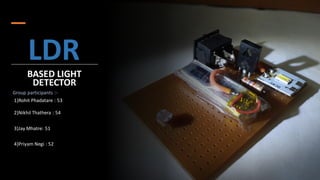
LDR-Based Light Detector Circuit
- 1. LDR BASED LIGHT DETECTOR Group participants :- 1}Rohit Phadatare : 53 2}Nikhil Thathera : 54 3}Jay Mhatre: 51 4}Priyam Negi : 52
- 2. THINGS USED •LDR •2.7k resistor •BD140 transistor •3.7V battery •SPST switch •4V LED
- 3. LDR • A Light Sensor generates an output signal indicating the intensity of light by measuring the radiant energy that exists in a very narrow range of frequencies basically called “light”, and which ranges in frequency from “Infra-red” to “Visible” up to “Ultraviolet” light spectrum.
- 4. RESISTORS • The electrical function of a resistor is specified by its resistance: common commercial resistors are manufactured over a range of more than nine orders of magnitude. The nominal value of the resistance falls within the manufacturing tolerance, indicated on the component.
- 5. 2.7k Ωresistor • A resistor is a passive two-terminal electrical component that implements electrical resistance as a circuit element. In electronic circuits, resistors are used to reduce current flow, adjust signal levels, to divide voltages, bias active elements, and terminate transmission lines, among other uses. High-power resistors that can dissipate many watts of electrical power as heat may be used as part of motor controls, in power distribution systems, or as test loads for generators.
- 6. BD140 transistor • BD140 is a very famous PNP transistor uses in various electronics circuits. BD140 transistor can handle current upto 1500mA or 1.5A due to this feature. It can control high power LEDs, motors, relays etc because it can control loads upto 1.5A. This Transistor has many other ideal features like high collector emitter and collector base voltage that is 80 volts. Moreover, the collector dissipation of BD140 is around 12.5 watt that is way it is a good transistor to use in audio amplifier circuits. Minimum saturation voltage of the transistor is -0.5V.
- 7. BATTERY • Batteries are classified into primary and secondary forms: • Primary batteries are designed to be used until exhausted of energy then discarded. Their chemical reactions are generally not reversible, so they cannot be recharged. When the supply of reactants in the battery is exhausted, the battery stops producing current and is useless.[28] • Secondary batteries can be recharged; that is, they can have their chemical reactions reversed by applying electric current to the cell. This regenerates the original chemical reactants, so they can be used, recharged, and used again multiple times.
- 8. SWITCH • In electrical engineering, a switch is an electrical component that can disconnect or connect the conducting path in an electrical circuit, interrupting the electric current or diverting it from one conductor to another.The most common type of switch is an electromechanical device consisting of one or more sets of movable electrical contacts connected to external circuits. When a pair of contacts is touching current can pass between them, while when the contacts are separated no current can flow.
- 9. SPST SWITCH • A Single Pole Single Throw (SPST) switch is a switch that only has a single input and can connect only to one output. This means it only has one input terminal and only one output terminal. • A Single Pole Single Throw switch serves in circuits as on-off switches. When the switch is closed, the circuit is on. When the switch is open, the circuit is off. • SPST switches are, thus, very simple in nature. • Single Pole Single Throw (SPST) Switch Circuit:- • When the SPST is closed, the circuit is closed and light from the lamp switches on. When the SPST is then opened, the light from the lamp goes out and the circuit is off. • This shows the basic nature and function of a SPST.
- 10. LED • A light-emitting diode (LED) is a semiconductor device that emits light when an electric current flows through it. When current passes through an LED, the electrons recombine with holes emitting light in the process. LEDs allow the current to flow in the forward direction and blocks the current in the reverse direction.
- 11. ADVANTAGES • It is easy to integrate with lighting systems such as automatic lighting systems. • LDR based light sensors are available in different shapes and sizes. • Flexible solution system. • The light sensor needs a small voltage and power for its operation. • A variety of set is available. • Design is attractive. • It is used for energy consumption or energy management by automatic control of brightness level in mobile phone and auto ON/OFF of street lights based on ambient light intensity. • It is integrated into the lighting system. • The light sensor needs a small voltage and needs power for its operation. • Phototransistor generates high current compare to photodiodes.
- 12. DISADVANTAGES • LDR is highly inaccurate with the high response time. • The photodiodeis temperature sensitive and is unidirectionalunlike photoresistor, • Resistance varies continuously in photoresistorsand is tuggedin nature. • Photodiodesare temperature sensitivevoltage and are unidirectional,unlike photoresistor. • High initial investment. • Phototransistorcan not withstandvoltage above 1000volts. • The phototransistoris vulnerable to surges, spikes, and EM energy. • Separation of power circuitand command more connection,more cabling.
- 13. FOR REFERENCE:- • https://en.m.wikipedia.org/wiki/Photoresist or • https://alltransistors.com/transistor.php?tra nsistor=24718 • https://projectpoint.in/index.php?route=pro duct/product&product_id=499991556765